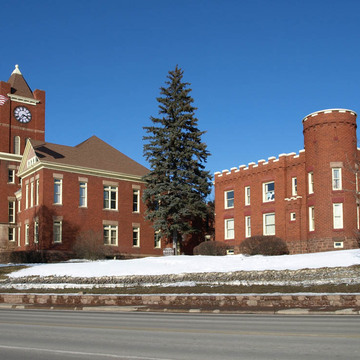In 1896, five years after Dickinson County was established by the state legislature by dividing Menominee County, voters elected to borrow $32,000 to acquire a site and build a courthouse and jail. Until then the county leased space in the Wood Building in the 200 block of E. Ludington Street. The new site occupies a full block on a hillside south of the central business district, where it faces the main thoroughfare and is plainly visible from the trains that ran through the city on both railroads. Here the county built a formal rock-faced red brick Richardsonian Romanesque courthouse trimmed with Portage Entry red sandstone. With an entrance and bell, the clock tower rises eighty-eight feet over the city. The round-arched entrance, with prominent voussoirs, is flanked by granite columns. The building was designed by Clancy, who planned several courthouses in northern Michigan and Wisconsin, including the neighboring Iron County Courthouse ( IR1). E. E. Grip and Company of Ishpeming built the courthouse. The Iron Mountain Range Tribune (January 2, 1897) remarked that the “elegant, commodious and complete” county buildings seemed to mark “the progress of Dickinson County” and to place her “in the Front Rank of Progressiveness.” The medieval-looking castellated sheriff's residence and jail stand to the south of the courthouse.
You are here
Dickinson County Courthouse and Jail
If SAH Archipedia has been useful to you, please consider supporting it.
SAH Archipedia tells the story of the United States through its buildings, landscapes, and cities. This freely available resource empowers the public with authoritative knowledge that deepens their understanding and appreciation of the built environment. But the Society of Architectural Historians, which created SAH Archipedia with University of Virginia Press, needs your support to maintain the high-caliber research, writing, photography, cartography, editing, design, and programming that make SAH Archipedia a trusted online resource available to all who value the history of place, heritage tourism, and learning.







